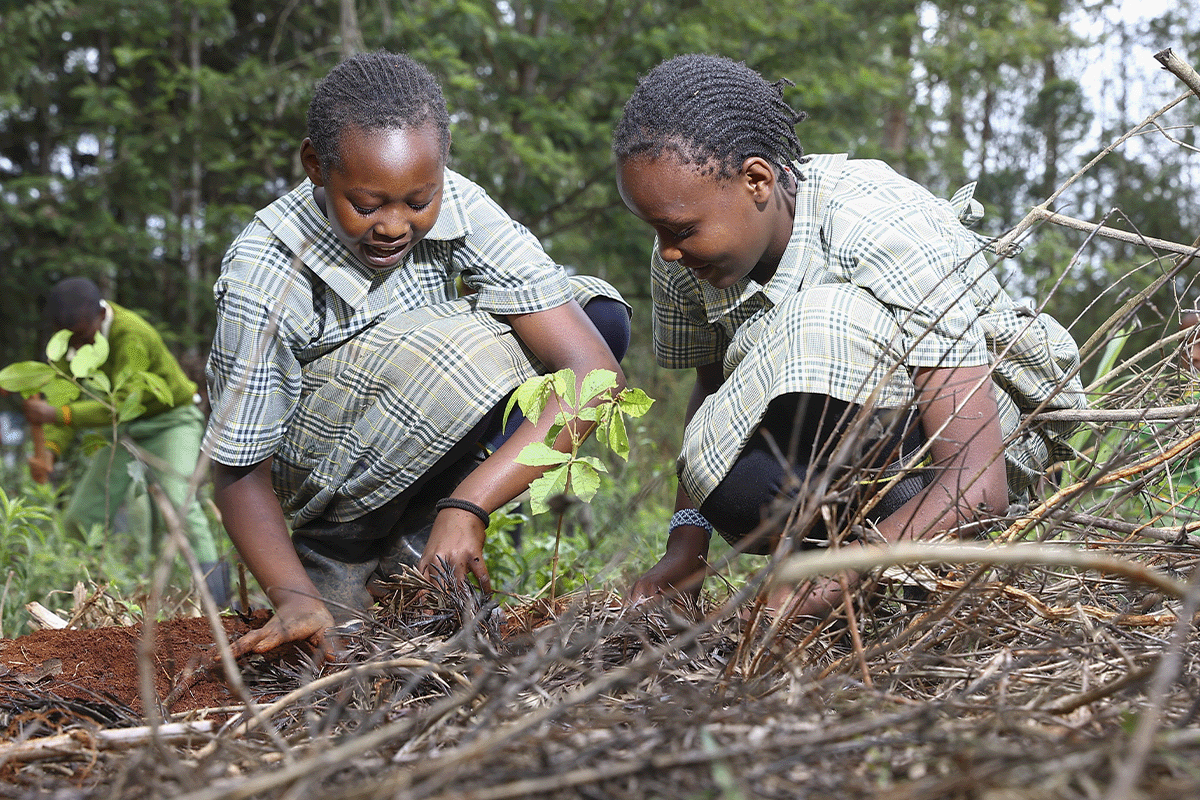Amidst the global efforts for nature conservation, understanding the intricacies of carbon markets has never been more crucial. As our planet faces ever-pressing environmental challenges, it has become clear that collective action is necessary. Carbon markets are an essential component of these endeavours, offering a structured approach to reducing carbon emissions and fostering sustainability.
 Close-up of young tree seedlings, Hongera Reforestation Project, DGB.
Close-up of young tree seedlings, Hongera Reforestation Project, DGB.
But where do we start on this complex journey? It begins with a lexicon, a dictionary of sorts, that helps us decode the language of carbon markets. Just as a map guides us through unfamiliar terrain, a comprehensive understanding of key concepts in the carbon market landscape is the compass we need to navigate this critical arena.
This blog serves as that compass, a guide to the key terms, concepts, and ideas that underpin the carbon market. By delving into these essential building blocks, we'll uncover the mechanisms, strategies, and interconnected nature of carbon markets. It's a journey that not only illuminates the path to a greener and more sustainable future but also empowers individuals, businesses, and governments to take an active role in addressing and protecting the natural environment.
Join us as we embark on a journey through the world of carbon markets, uncovering the meaning behind the terms and discovering the powerful connections they hold. Together, we'll unlock the door to a sustainable future where every action, every decision, and every voice counts.
The key concepts of carbon markets
As we explore these concepts, we will not only define them but also illuminate the intricate web of relationships that bind them together. So, whether you are a seasoned sustainability expert, a conscientious consumer, or simply someone seeking to grasp the essence of carbon markets, this blog is your gateway to knowledge, understanding, and engagement.
Article 6
|
Article 6 of the Paris Agreement is a critical component that outlines international cooperation on carbon markets. Within Article 6, there's a particular emphasis on Article 6.2, which introduces a framework for countries to collaborate on emissions reduction efforts. In essence, it allows one country to count the emissions reductions achieved by another towards their own environmental targets. This cooperative approach, supported by mechanisms like Internationally Transferred Mitigation Outcomes (ITMOs), offers an innovative way for nations to work together more effectively to support nature’s recovery. While the specific rules and mechanisms are still evolving, Article 6 represents a promising avenue for global environmental action through shared responsibility and emissions reduction, fostering global efforts to protect our planet collaboratively.
|
Cap-and-trade system
|
A cap-and-trade system, also known as ETS, is a carbon pricing mechanism in the regulatory carbon market that sets a limit (cap) on entities’ total emissions and allows them to trade emissions allowances. This market-based approach incentivises emission reductions and promotes environmental sustainability.
|
Carbon capture
|
Carbon Capture and Sequestration (CCS), often referred to as carbon capture and storage, is a process that begins by capturing a relatively pure stream of carbon dioxide (CO2) from industrial and energy-related sources. This captured CO2 is then conditioned, compressed, and transported to a designated storage site, where it undergoes long-term isolation from the atmosphere. Carbon capture technology is still evolving and is a technology-centric solution. While it might effectively prevent CO2 from entering the atmosphere, it doesn't offer the wide-ranging environmental benefits of nature-based offsetting. Carbon offsetting via nature presents a more comprehensive solution to carbon emissions due to its many additional benefits.
|
Carbon credits
|
A carbon credit (also known as a carbon unit) is a certificate that represents a certified reduction of one metric tonne of carbon dioxide (CO2) emissions. Carbon credits are generated by carbon projects that reduce or remove carbon emissions and are verified by carbon standards like the Verified Carbon Standard or the Gold Standard. Carbon credits are used in carbon markets to trade emissions reductions and offset hard-to-abate emissions, incentivising sustainable practices and net-zero emissions. Carbon credits are thus vital tools to restore nature.
|
Carbon farming
|
Carbon farming is an agricultural system that involves sustainable land management practices like regenerative agriculture that increase carbon sequestration in soil and vegetation. It offers many benefits, such as carbon reduction, increased soil health, biodiversity protection, improved water quality, and agricultural resilience and sustainability.
|
Carbon footprint
|
A carbon footprint is the total amount of greenhouse gases, primarily CO2, that an individual, organisation, or product is responsible for emitting. It represents their environmental impact. Measuring, understanding, and reducing your carbon footprint is a fundamental step in achieving net zero.
|
Carbon market
|
A carbon market is a marketplace where carbon credits are bought and sold. Companies and organisations use the carbon market to buy and trade carbon credits to offset their emissions. The carbon market plays a significant role in supporting environmental goals. It's a platform where sustainability and economic incentives meet to protect nature.
|
Carbon pricing
|
Carbon pricing includes mechanisms like carbon taxes, cap-and-trade systems, and the voluntary carbon market that place a financial cost on carbon emissions. Carbon pricing seeks to internalise the external costs associated with carbon emissions, creating economic incentives for industries and organisations to reduce and offset emissions and take environmental action.
|
Carbon projects
|
Carbon projects encompass a wide range of initiatives aimed at reducing or removing carbon emissions. These projects often include reforestation efforts, renewable energy installations, energy efficiency improvements, and sustainable land management practices. By promoting carbon sequestration and reducing emissions, these projects play a vital role in addressing nature conservation and building a more sustainable future. Nature-based carbon projects like reforestation are often seen as more beneficial due to the many environmental and socio-economic benefits they can offer in addition to carbon sequestration.
|
Carbon standard
|
A carbon standard is a set of guidelines and criteria used to assess the quality and authenticity of carbon credits generated by carbon projects. It ensures transparency and accountability in carbon offset projects. Leading carbon standards include the Verified Carbon Standard and the Gold Standard.
|
Carbon taxes
|
Carbon taxes are a government policy tool that places a tax on the carbon content of emissions sources. This pricing strategy incentivises individuals and businesses to reduce their carbon emissions by attaching a cost to polluting activities. It's an effective way to encourage cleaner energy adoption and environmentally responsible practices, playing a key role in addressing the need to protect nature.
|
Circular economy
|
A circular economy is a system that promotes the reduction, reuse, and recycling of resources, minimising waste and environmental impacts. It is a sustainable approach to production and consumption. Products don't exit the system but are designed to continually circulate within it. The emphasis is on reducing waste and environmental impacts by extending the life of products through reuse, repair, and recycling. This perpetual reuse and recycling loop not only conserves resources but also minimises the burden on the environment, making it a holistic and eco-conscious approach to managing our finite resources.
|
Decarbonisation
|
Decarbonisation involves reducing the carbon intensity of industries and economies by transitioning to cleaner energy sources, lowering carbon emissions, and ultimately achieving net zero. Decarbonisation is key to achieving net zero and creating a circular economy.
|
Emission Reduction Units (ERUs)
|
Emission Reduction Units (ERUs) represent carbon emissions reductions achieved through projects and activities in various sectors, particularly associated with the Kyoto Protocol. They are certified through the Clean Development Mechanism (CDM) executive board and generated through certified projects that adhere to stringent international standards. They are usually linked with projects under the CDM and used in regulatory markers like the EU ETS. Unlike Verified Emission Reductions (VERs), which are utilised in the voluntary carbon market, ERUs focus on facilitating emissions reductions between countries.
|
ESG
|
ESG stands for Environmental, Social, and Governance. It refers to a set of criteria used to assess a company's performance in areas related to sustainability, social responsibility, and corporate governance. ESG reporting is crucial for companies’ sustainability success and is of growing importance to investors.
|
ETS
|
ETS, the abbreviation for Emissions Trading System, is a market-based approach that sets a cap on carbon emissions from specific sectors or entities and allows the trading of emission allowances. This innovative system promotes emissions reductions in various sectors and fosters competition in finding the most cost-effective methods to curb emissions, making it a valuable tool in protecting the environment.
|
Gold Standard
|
The Gold Standard, a rigorous certification label, sets a high benchmark for the quality and integrity of carbon offset projects. Established in 2003, this standard was designed to ensure that carbon projects adhere to stringent environmental and social criteria. The Gold Standard goes beyond merely reducing emissions; it promotes sustainable development by demonstrating real and additional benefits to local communities and ecosystems. Projects that receive the Gold Standard certification are known for their transparency, robust monitoring, and the delivery of genuine climate and sustainable development impacts. This prestigious standard provides assurance to investors and participants that their contributions lead to meaningful and positive changes for both the environment and society.
|
Green bonds
|
Green bonds, a pivotal financial innovation, are financial instruments designed to raise capital for environmentally friendly projects. These projects encompass a wide array of sustainability initiatives, ranging from conservation and reforestation efforts to renewable energy development and carbon reduction programmes. Green bonds attract eco-conscious investors who seek both financial returns and the satisfaction of contributing to a more sustainable and environmentally responsible future.
|
Kyoto Protocol
|
The Kyoto Protocol is an international treaty that sets legally binding emissions reduction targets for developed countries, paving the way for global environmental action. It was adopted before the Paris Agreement and played a pivotal role in shaping environmental policy. While it is still in force, the Paris Agreement is now the main reference for global environmental action.
|
Mitigation
|
Mitigation encompasses a set of proactive actions and strategies designed to reduce or prevent the release of carbon emissions, thereby curbing its harmful environmental impacts. These measures are not only critical for environmental conservation but also for minimising our ecological footprint and promoting a healthier, more sustainable world.
|
Nature-based projects
|
Nature-based projects and solutions constitute a diverse array of initiatives that leverage the remarkable capabilities of natural ecosystems to address the challenges posed by environmental degradation. These projects encompass endeavours like reforestation, wetland restoration, afforestation, and sustainable land management practices. By doing so, they not only capture and store carbon but also foster biodiversity, enhance ecosystem resilience, and contribute to the broader goal of creating a harmonious and ecologically sound world. These projects often also offer many socio-economic benefits to local communities, like job creation, infrastructure development, training, and energy-efficient stoves that improve community health.
|
Net zero / carbon neutrality
|
Net zero, often referred to as carbon neutrality, signifies a remarkable equilibrium wherein the total carbon emissions generated are counterbalanced by the volume removed or offset through a variety of means like carbon credits. This state represents a pivotal milestone in the quest for environmental sustainability, symbolising a world in which the scale of emissions no longer surpasses the capacity to mitigate them, thus playing a central role in preventing further exacerbation of environmental issues.
|
Offsetting
|
Carbon offsetting or carbon compensation involves offsetting your hard-to-abate emissions (emissions that cannot be reduced) by investing in projects that reduce or remove emissions and restore nature. Carbon offsetting is done through carbon credits, and it is a vital tool to reduce your environmental footprint.
|
Paris Agreement
|
The Paris Agreement, a historic international treaty adopted under the United Nations Framework Convention on Climate Change (UNFCCC) in 2015, stands as a beacon of global cooperation in the face of pressing environmental challenges. This landmark accord aspires to restrict the rise in global temperatures to levels significantly below 2°C above the pre-industrial baseline. By uniting nations and stakeholders in this collective pursuit, the agreement forges a path towards a more sustainable and resilient future, underlining the imperative of addressing environmental crises for the wellbeing of present and future generations.
|
Scope 1, 2, and 3 emissions
|
Scope 1, 2, and 3 emissions serve as a systematic framework for categorising and quantifying carbon emissions, enabling organisations and sectors to gain a comprehensive understanding of their environmental impact. Scope 1 emissions encompass direct emissions from sources under an organisation's or sector's control, such as emissions from on-site fuel combustion or industrial processes. Scope 2 emissions relate to indirect emissions produced from purchased electricity and heating and cooling, reflecting the environmental consequences of the energy sources an entity uses.
Scope 3 emissions extend further to capture indirect emissions associated with an organisation's value chain, including activities such as business travel, supply chain emissions, and product life cycles. By categorising emissions in this manner, organisations can identify opportunities for reduction and engage in more effective environmental action strategies across their entire operational spectrum.
|
Sustainability
|
Sustainability goes beyond the here and now, striving for a harmonious and lasting relationship with the planet by embracing practices and strategies that not only balance economic prosperity, social equity, and environmental stewardship but also safeguard the wellbeing of present and future generations. It refers to the ability to meet the needs of the present generation without compromising the ability of future generations to meet their own needs through the sustainable use of resources. This also entails addressing carbon footprints.
|
Triple bottom line
|
The triple bottom line framework serves as a transformative tool for businesses, pushing them to evaluate their performance through a multi-dimensional lens that takes into account not only financial profit but also their social and environmental contributions, thereby fostering a more holistic and responsible approach to success.
This framework differs from Environmental, Social, and Governance (ESG) criteria in its scope. While ESG primarily evaluates a company's overall impact and behaviour from a third-party perspective, the triple bottom line focuses on measuring the success of a company based on three dimensions: profit, people, and the planet. It not only assesses a company's sustainability practices but also highlights the necessity of contributing positively to social and environmental factors, treating them as integral components of financial success. In essence, ESG is a broader evaluation of a company's ethical and sustainable performance, whereas the triple bottom line embeds these considerations deeply into the core of business operations and strategy. The choice between ESG and triple bottom line depends on the specific goals and values of a company.
|
Voluntary carbon market
|
The voluntary carbon market, also referred to as the verified carbon market, offers individuals and organisations a proactive and voluntary means to take responsibility for their carbon emissions by purchasing carbon credits. These credits fund projects and initiatives aimed at reducing carbon emissions and restoring nature, thus aligning personal or corporate environmental stewardship with collective efforts to conserve nature and contribute to a more sustainable world.
|
Voluntary Emission Reductions (VERs)
|
VERs are emissions reductions achieved through voluntary actions that go beyond legal obligations. They are created through initiatives like reforestation and adopting cleaner technologies. These reductions are independently verified and certified by various bodies like Verra and the Gold Standard and can be traded as carbon credits in voluntary carbon markets, contributing to environmental sustainability and responsible carbon management.
|
Verified Carbon Standard
|
The Verified Carbon Standard (VCS) is a rigorous and globally recognised framework by Verra comprising comprehensive guidelines and protocols that meticulously assess and verify the authenticity, environmental integrity, and quality of carbon credits. By adhering to these standards, carbon offset projects can uphold transparency and credibility, providing assurance to investors and participants that their contributions indeed contribute to meaningful emissions reductions and sustainable practices, further reinforcing the integrity of carbon markets and environmental responsibility.
|
Connecting carbon market concepts
 Pupils planting seedlings, school in Kenya, Hongera Reforestation Project, Kenya, DGB.
Pupils planting seedlings, school in Kenya, Hongera Reforestation Project, Kenya, DGB.
The intricate web of carbon market concepts converges to create a dynamic and interconnected landscape that fosters global environmental action and sustainability. Article 6 of the Paris Agreement stands as a linchpin, laying the foundation for international cooperation on carbon markets. Within this framework, the cap-and-trade system, or Emissions Trading System (ETS), emerges as a pivotal mechanism. This market-based approach, outlined in Article 6.2, sets a cap on emissions and allows entities to trade allowances, incentivising emission reductions and promoting environmental sustainability.
Read more: Key players in evolving carbon markets
Integral to the carbon market system are carbon credits. These credits are generated by diverse carbon projects, including nature-based projects which incorporate carbon farming. Carbon farming not only reduces emissions but also contributes to increased soil health, biodiversity protection, and agricultural sustainability.
Read more: 100 Reasons carbon credits are the best thing that ever happened to improve conditions on our planet
The carbon market further intertwines with the concept of carbon pricing, which includes mechanisms like ETS, carbon taxes, and the voluntary carbon market. Carbon taxes place a financial cost on emissions, encouraging industries to reduce their carbon footprint. The voluntary carbon market, on the other hand, offers individuals and organisations a proactive means to offset emissions voluntarily, exemplified by Verified Emission Reductions (VERs).
The overarching goal of the carbon market is to contribute to sustainability by aligning economic incentives with environmental stewardship. The concept of sustainability goes beyond the carbon market, encompassing practices and approaches that seek to balance economic prosperity, social equity, and environmental stewardship for long-term wellbeing.
Read more: The power of sustainability: Why investing in sustainability drives faster company growth
Carbon offsetting, a key aspect of the voluntary carbon market (and regulatory market), is complemented by the broader concept of net zero or carbon neutrality. Achieving net zero involves balancing emissions with removals or offsets, highlighting the crucial role of offsetting practices to reduce carbon footprints. This crucial mechanism within the carbon market is overseen by carbon standards like the Verified Carbon Standard and the Gold Standard, ensuring the quality and authenticity of carbon credits.
A circular economy, a sustainable approach to production and consumption, underpins these efforts. It promotes the reduction, reuse, and recycling of resources, minimising waste and environmental impacts.
Read more: Era of revolution: groundbreaking carbon market development
The integration of ESG and the triple bottom line further enhances this interconnected framework by incorporating a broader evaluation of companies' ethical and sustainable performance, embedding these considerations deeply into the core of business operations and strategy.
 Tree seedlings ready to plant, Hongera Reforestation Project, DGB.
Tree seedlings ready to plant, Hongera Reforestation Project, DGB.
Beyond the market dynamics, the carbon market is deeply entwined with global environmental frameworks like the Kyoto Protocol and the Paris Agreement. These agreements set legally binding emissions reduction targets and create a roadmap for nations to collaborate on mitigation efforts.
As we traverse the carbon market landscape, each concept plays a distinctive yet interconnected role, collectively contributing to the overarching goal of creating a more sustainable and resilient future.
DGB Group: making carbon markets accessible to all
In the realm of carbon markets, DGB Group stands as a beacon dedicated to making this intricate landscape accessible to all. Our commitment is woven into impactful nature-based projects, where we harness the power of nature to address not only carbon emissions but also social and environmental challenges. As stewards of large-scale, high-quality projects accredited by leading verification standards, we go beyond the conventional, focusing on nature conservation and fostering biodiversity.
 Thomas Donia, DGB Group Director of Operations, taking part in the DGB project validation under Verified Carbon Standard (VCS).
Thomas Donia, DGB Group Director of Operations, taking part in the DGB project validation under Verified Carbon Standard (VCS).
We extend an invitation to our readers, urging them to take their first steps toward environmental engagement. It's not merely about carbon footprints; it's about embracing nature as a solution. Dive into our projects, explore the tangible impact of carbon offsetting—a vital tool to restore nature—and find equilibrium in your carbon footprint. Discover the potential of carbon credits, where verified impacts become opportunities for businesses and communities to invest in nature.
At the heart of it all is the essence of DGB: our dedication to making the carbon market an inclusive space where individuals, organisations, and communities can actively contribute to a more sustainable and resilient future. Join us on this journey of balancing the scales, restoring nature, and forging a path towards a world where our actions not only mitigate emissions but also nurture the rich tapestry of life on our planet. Take that first step with us, and together, let's make a lasting impact on the carbon market and the world we call home.
Are you ready to ignite change with DGB? Calculate your carbon footprint now






